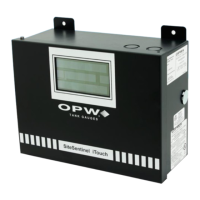Doc. No.: M1500 Rev. 5
Page 66 of 127
• 67733 Gross Point Road 900 Santa Fe Dr.
Doc. No.: M1500, Rev. 5
Page 66 of 127
67733 Gross Point Road 900 Santa Fe Dr.Doc. No.:
M1500, Rev. 5
Page 66 of 127
• 67733 Gross Point Road 900 Santa Fe Dr.
•
2. Set the lower alarm threshold to 0.2 volts and set the upper alarm threshold to 5.0 volts (disables upper
threshold).
3. Program the alarms associated with the lower threshold that you wish to activate if the sensor detects
liquid.
14.1.11 Testing the Interstitial Optical Liquid Sensor
To prevent the possibility of explosion or fire, do not test the sensor in the
Hazardous Area.
Work in a well-ventilated area with no hot surfaces or open flames.
Do not use fuel to test the sensor!
1. Immerse the sensor in water. This should trigger the alarm in the Controller.
2. Remove the sensor from the water. Confirm that the Controller is no longer in alarm.
If the Controller fails to go in to alarm condition, check that the thresholds programmed in the system are
correct. Disconnecting the sensor should trigger an alarm. Shorting the sensor should be out of alarm. Check
all wiring and junction boxes to ensuring continuity without shorts.
1.28 30-3224 Combo Single Level/Hydrocarbon Liquid Sump Sensor
About the 30-3224
This combination sensor is made from a Hydrocarbon Liquid Sump Sensor (30-3219-12) with an Interstitial
Level Sensor (30-3221-1A) clipped to the side.
The sensor is designed to detect the presence of liquid hydrocarbons and water in sumps, dispenser pans and
other locations where the presence of a liquid could indicate that a leak has occurred.
The sensor contains a carbon/polymer material that changes its resistance when exposed to liquid
hydrocarbons. A float switch simply clips onto the hydrocarbon sensor and can be positioned at any desired
height to activate in the presence of liquid
This sensor can be used to monitor wet wells to ensure that a liquid is normally present. In the event of a break
in the cable, the system will activate the alarm.

